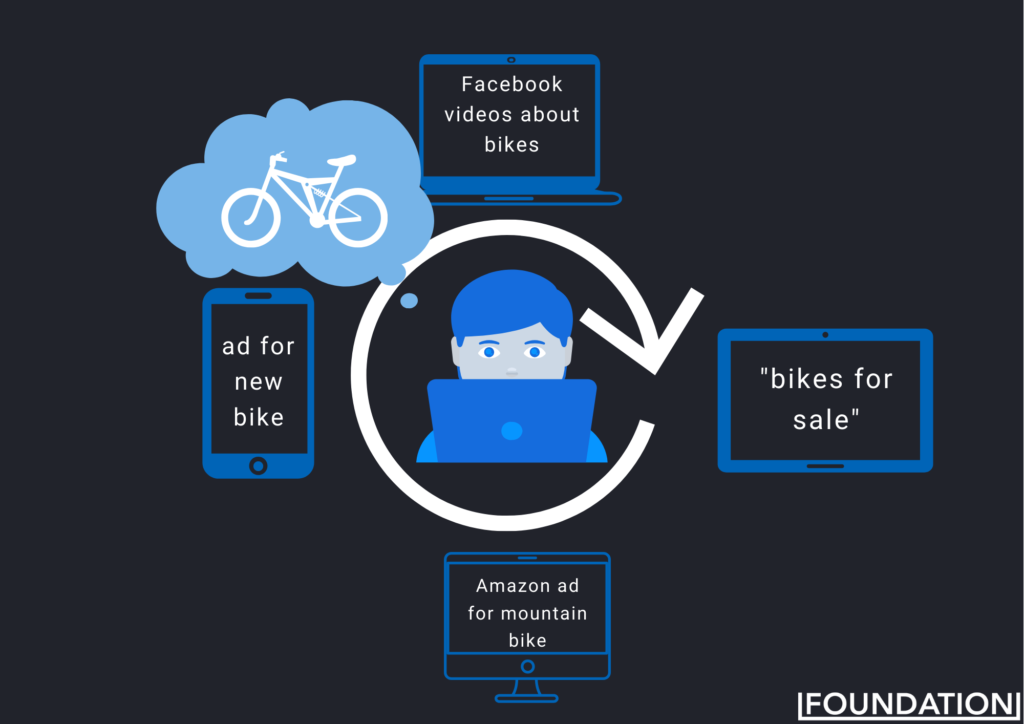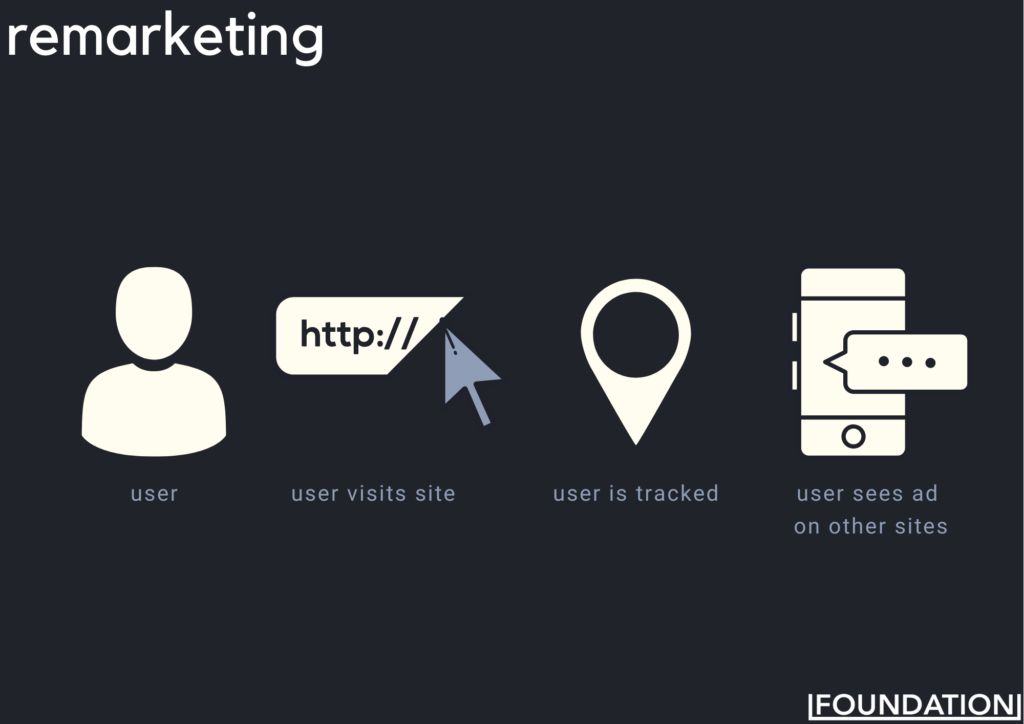Article's Content
What Is Remarketing?
You know how ads for the products and websites you browse suddenly show up on Facebook the next time you visit? That’s remarketing.
Typically only 2% of consumers will convert the first time they visit a website. Your digital marketing campaign is more likely to bring positive results if you offer prospective customers a second chance to become actual customers. Remarketing gives you the opportunity to speak directly to potential consumers who have visited your brand’s website.
It allows your brand to “follow” these users around the internet by displaying more ads on the websites and platforms they use most.


The main purpose of remarketing is to reach users who are already aware of your brand or your products/services and therefore have a much higher chance of converting. The ads target the user on several occasions, using personalization, and encourage the user to move along the sales funnel.
How Does Remarketing Work?
The remarketing process is broken into four steps:
- The user visits your brand’s website.
- Thanks to a few lines of code from your retargeting partner (e.g., Google AdWords), the user is tagged with a cookie. This cookie is a tiny file in their browser that stores various bits of information about the user and tracks their site visits. Different types of cookies track different activities:
-
- Session cookies are used only when a user actively navigates through a website; once they leave the site, the session cookie disappears.
- Tracking cookies create long-term records of multiple visits to the same site.
- Authentication cookies track whether a user is logged in and under what name.
-
An important note: The cookie does not store any sensitive personal information like name, age, or location.
- When the tagged user leaves your site to browse the web, get on social media, or do pretty much anything online, the cookie tells the ad platform where that user is going.
- You analyze where the user spent time on your site in order to serve up something related to the content they were interested in. Then your brand launches a campaign with ads shown only to tagged users.
Depending on how users came across your content and how they were tagged, they are shown different types of ads:
- Dynamic (Desktop or Mobile): Display ads that appear on websites and apps to people who have previously visited a brand’s webpage. The ads are personalized based on the products or pages the users were looking at on the website.
- Search Engine: Ads that appear in search results after users have already visited a brand’s website. This allows for narrow targeting: Not only have these people already visited the site, but they are still searching for things related to the brand’s products or services.
- Distribution Lists: The brand chooses to have ads shown to a specific list of previously collected email addresses through gated content on site to gather contact info.


Why Use Remarketing?
Why remarketing works: personalization + keeping your brand in front of the user everywhere they go.
The effects: greater reach + higher conversion rate
Higher conversion rate:
- Remarketing makes it possible to reach out to users right when they are most likely to convert.
- Users have already shown interest in your brand.
- Carefully choosing where your ads are shown, you can personalize your points of contact for the greatest impact.
Greater reach:
- Google AdWords’ display network has 2 million+ websites and apps.
- Other retargeting tools, like Facebook Ads, also offer impressive outreach abilities.
- To put it simply: You can reach users who are potentially interested in your products or services, no matter where those users are.
Maximum personalization:
- Personalizing remarketing lists offer an endless amount of possibilities.
- There are two key tactics:
- Tracking the pages that users visit on your website and how long it’s been since they visited
- Targeting users with different interests wherever they are in the sales funnel process
Brand reminder:
- Your brand remains top of mind for your users, and you can maintain a relationship with them
- If users have subconsciously made a purchase decision, your remarketing ads can subtly remind them
Unlike other forms of advertising, consumers don’t seem to mind remarketing. As many as a quarter of customers have stated that they actually enjoy retargeting ads. These ads spark more interest than standard ads, serving as convenient reminders and improving the user experience.


How To Start Remarketing
Most (if not all) marketers use Google AdWords for remarketing. This is because of Google’s size. Leveraging the largest search engine in the world means your campaign will be able to reach a TON of sites.
But you need to do a little prep before you invest in remarketing ads:
Determine Your Goals
Establish the goals of the remarketing campaign.
- Do you want to target visitors who engage with anything on your site?
- Do you want to target visitors who put items in their cart but did not check out?
- Do you want to target visitors who have not been to a certain page on your site?
You need to identify your goal before creating the campaign on Google AdWords.
Create A Remarketing Tag
Before creating your campaign, generate a list of the people who have already visited your site.
You can find directions on how to create an audience list and remarketing tag in Google Ads Help, but we’ll explain it here too:
Audience List
- Log in to your AdWords account and click the Tools icon. Under Shared Library, select Audience Manager.
- In the Remarketing tab, go to Audience Lists and click the + icon. Choose Website Visitors.
- Fill out the form to create your list.
Remarketing Tag
- Set up your remarketing tags.
- Log in to your Google Analytics account:
- Go to Admin > Tracking Info > Data Collection
- Turn on the Remarketing and Advertising Reporting features
- Go back to your AdWords account, click on the Tools icon, and select Audience Manager again.
- Go to the Audience Source tab on the left and select Google Analytics.
- Fill out your details there to successfully connect your remarketing tag to your Analytics account.
Start Your Remarketing Campaign in Google AdWords
- Go to Campaign on the left sidebar and click the + icon to create a new one.
- Select your account and choose the goal for the campaign.
- Select the campaign type.
- Choose Display so your ads will appear on sites and apps that are part of the Google Display Network.
- Next, choose the Standard display campaign and enter the URL of the site where you placed your remarketing tag.
- On the next page, fill out the name of the campaign, your proposed bid, and your budget.
- Next, create an ad group. This is where you can set up your remarketing list. Under Audiences, click How they have interacted with your business and select the remarketing list you just created.
- Finally, click Create Campaign.
It’s that easy! In a few simple steps, you can create your remarketing campaign and start seeing results for your brand.
Check out the Customer Journey Map to find out more about the customer buying process and put your remarketing plans into action.






